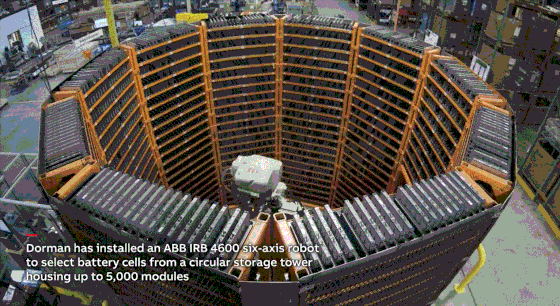Dear Reader,
I’ve spoken recently about the volatility in the markets… high inflation… interest rates… and the many concerns investors have right now.
We’ve entered a period of higher uncertainty, and no one wants to make the wrong move. That’s why I want to guide readers through the ups and downs of the stock market.
Yet I don’t want the current situation to overshadow the opportunity that’s before us.
As I wrote on Friday, my team and I are still on the hunt for companies disrupting their respective industries. Their bleeding-edge technologies enable products and services that are transforming the way we live.
Likewise, our targets are scaling their businesses. They are growing and expanding profits… and bringing us the chance for exponential returns.
The companies that meet these criteria are often small-caps. When we invest early in a company’s life cycle, we get in when the potential upside is highest.
And even in times of volatility, companies with these traits can thrive.
That’s what I’ve spotted right now. Our current circumstances are acting as tailwinds for a specific technology trend … one that’s going to help us earn back everything we may have lost in the recent pullback – and much, much more.
This Wednesday night, at 8 p.m. ET, I’ll be sharing my thoughts on what we can expect from the market in the year ahead… and how we can position ourselves to profit from this technology revolution.
I’ll even be giving away the name and ticker of a company I believe could be an easy double in 2022…
So if you haven’t yet reserved your spot for this exclusive briefing, please make sure to do so for free right here.
If you have any money in the market right now, you won’t want to miss this event.
India’s finance minister just announced that the country will launch an official blockchain-based national digital currency.
This will be India’s central bank digital currency (CBDC). We can think of it as the digital version of the rupee. This is a big deal given both the population of the country, as well as the diaspora of Indians living around the world.
We have talked about countries launching CBDCs quite a bit in The Bleeding Edge. But other than China, most CBDC projects have been led by small island nations.
In fact, China is the only major country to announce its own CBDC. China has been testing its digital currency for over a year now throughout several major cities. People are even using it at the Beijing Winter Olympics as an approved method of payment.
So India’s move is a major announcement. And it has even bigger implications…
Think about this – China and India are each home to about 1.4 billion people. That’s 2.8 billion people total out of a global population of 7.9 billion.
That means 35% of the world’s population will soon live within a CBDC-dominated financial system. Just two countries, and more than a third of the world’s population – pretty incredible.
And this will prompt the United States and other developed countries to act.
Indeed, the Federal Reserve recently released a paper highlighting the risks and benefits of a digital dollar days ago. The Fed is soliciting public feedback on the paper to determine a path forward.
To me, it’s clear that the Fed plans to launch a CBDC imminently. It is my opinion that its plans to launch its own digital currency are closely tied to the U.S. Securities and Exchange Commission’s (SEC) heavy-handed regulation with regards to cryptocurrencies and other digital assets.
It’s also the reason why Facebook/Meta was “forced” to sell off its stablecoin project – Diem. There was no way that the Federal Reserve was going to allow the social media company to play the role of managing a proxy for the U.S. dollar.
That said, I hope the U.S. does not imitate the hostilities China and India have shown toward the digital asset industry as part of its CBDC initiative.
The best case scenario would be an opening of regulations that are supportive of innovation and include access for all investors, not just high-net-worth individuals.
An example of what we don’t want is what has been proposed in India. India announced that it will tax any income generated from digital assets other than its CBDC – cryptocurrencies or non-fungible tokens (NFTs) – at 30%.
That’s incredibly excessive. It places any income or profits from digital assets in the highest tax bracket in India.
And it’s clearly meant to be an attack on the digital asset industry. Both China and India want to maintain absolute control over all digital assets in their countries.
Not only am I hoping that things improve in the U.S., but organizations like the Chamber of Digital Commerce and the Blockchain Association have been working hard to effect a more productive and fair outcome with U.S. regulators and policy makers.
2022 is going to be an exciting year. I expect the Federal Reserve will have to step up and announce its plans for its own CBDC.
This will be the beginning of the end of paper currency. And in time, physical U.S. dollars won’t be accepted as a form of payment.
A robotics industry group called the Association for Advancing Automation (A3) just published some interesting data. It shows that North American firms are spending money on robots at record levels.
Specifically, North American firms spent over $2 billion on robots last year.
That’s an annual record. And it represents a 28% increase over 2020. The increase represented the purchase of more than 40,000 robotic units, which is also a record.
As a reminder, we saw a major shift in industry adoption thanks to the COVID-19 pandemic. The labor shortage gave companies no choice but to take the leap and fill in the gap with robotics and other automation technology.
What is also interesting about this shift is which sectors have led this adoption. Historically, the auto industry has been the primary adopter of robotics technology.
It has always been responsible for more than half of all robotics adoption due to the scale of the automotive industry and the need for robotics to both scale production lines and keep costs down.
Since early 2020, however, we have seen the most adoption in logistics facilities and distribution warehouses. This is directly tied to the e-commerce boom that the pandemic brought about.
A great example of this is DHL’s recent $15 million investment in robotics company Boston Dynamics, which is now owned by South Korean conglomerate Hyundai. We talked about that a few weeks ago.
The bottom line is that COVID-19 – and the public policies around it – kicked the adoption of robotics technology into high gear.
And this is a trend that’s only going to accelerate from here.
Warehouse Robotics

Source: Automate.org
We’re looking at an irreversible shift in the workforce here. Robotics is simply too efficient to ignore any longer. The data shows that robots can help companies operate with about half the human labor force, yet see production increases of up to 200%. That’s impossible to ignore.
And another key point is that robots aren’t replacing human jobs. They are replacing work that needs to get done but is currently not being fulfilled. And as we have seen with the ongoing labor shortages, this was work that humans didn’t want to do anyway.
This is a huge trend for 2022 after two strong years of growth. Even though we are coming out of the pandemic, the labor shortages persist, and the cost and productivity advantages are simply too large to ignore.
The pioneers in this space are absolutely the kind of companies that can turn into “100-baggers.”
We’ll be tracking this trend closely this year… And if any readers want to learn about some promising companies at the forefront, simply go right here for more details.
Starlink is now offering a premium version of its satellite internet service. This announcement shows how much progress the project has made.
As a reminder, Starlink is a subsidiary of Elon Musk’s SpaceX. It’s working to create a satellite network for the planet that can provide communications access to anywhere on the globe.
And this includes a satellite internet service for consumers.
At launch, Starlink’s internet service had just one tier. The hardware cost $499 at installation, and then the service cost $99 per month.
And it was limited to just a small geographic area. This was largely defined by where the Starlink satellites had been placed into orbit.
As for performance, Starlink announced that users could expect speeds between 50 megabits per second (Mbps) to 150 Mbps. For comparison, the average cable TV internet service provides speeds between 200 and 300 Mbps with much lower latency.
So the first tier is – at best – about half as good as standard cable internet. That’s why having a premium tier is so important.
Starlink’s high-end service will offer speeds between 150 Mbps and 500 Mbps. That makes it competitive with cable internet. But it’s not cheap.
To start with, the hardware for the premium service costs $2,500 up-front. Then consumers will pay $500 per month after that. That’s a 5X increase in price on both hardware and monthly service fees.
I’m very interested to see how this is adopted. I suspect that this service will only make sense for businesses and a small number of individuals who need high speeds and some level of guaranteed quality of service for their work.
Still, this is a great supplementary offering for both Starlink and consumers. And it’s happening at a time when Starlink has already achieved some incredible milestones:
More than 150,000 subscribers across 25 countries
Almost 2,000 Starlink satellites are now in orbit
All of this was accomplished in just over two years
Incredible progress! But, of course, what happened with Starlink’s latest satellite launch has completely overshadowed it.
In short, a geomagnetic storm caused about 40 satellites from the most recent launch to crash and burn. Here’s a visual:
Starlink Satellite Debris

Source: Business Insider
What we are looking at here isn’t fireworks. We’re looking at pieces of satellites that the geomagnetic storm “pushed” back into Earth’s atmosphere before they could achieve their intended orbit.
The media has focused on this event. But it’s irrelevant in the context of the big picture.
This is little more than a small blip of bad luck. It won’t stop the progress that Starlink is making. Thousands more satellites will launch this year to support the satellite internet service.
And with this new tier and all of the success, Starlink is one step closer to a potential initial public offering (IPO)…
Regards,
Jeff Brown
Editor, The Bleeding Edge
Like what you’re reading? Send your thoughts to feedback@brownstoneresearch.com.
The Bleeding Edge is the only free newsletter that delivers daily insights and information from the high-tech world as well as topics and trends relevant to investments.
The Bleeding Edge is the only free newsletter that delivers daily insights and information from the high-tech world as well as topics and trends relevant to investments.